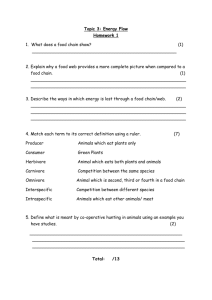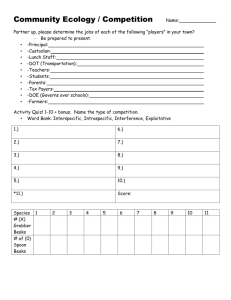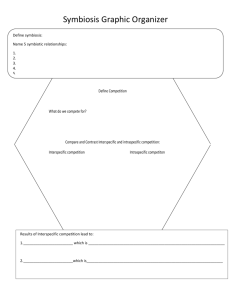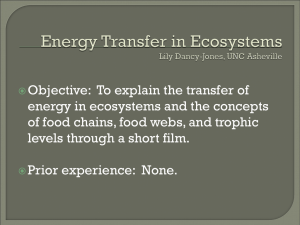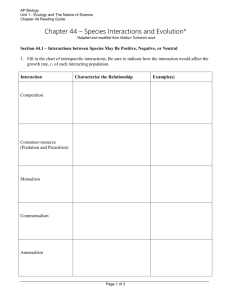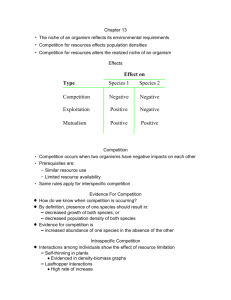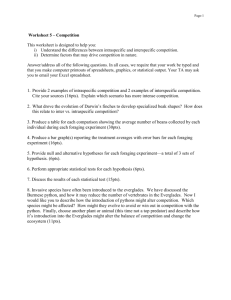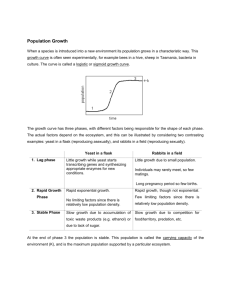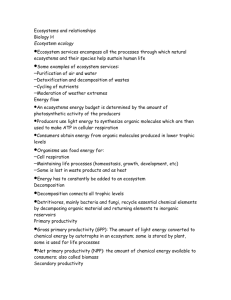Consumer–resource interactions
advertisement
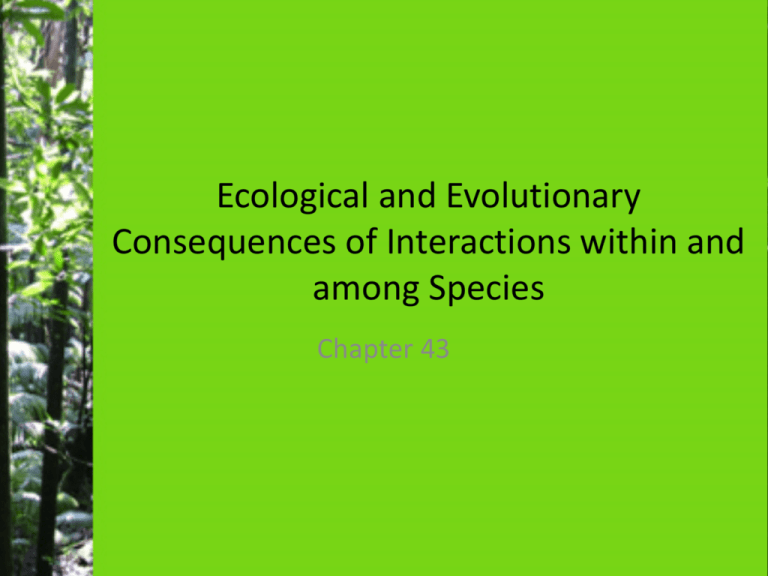
Ecological and Evolutionary Consequences of Interactions within and among Species Chapter 43 Chapter 43 Ecological and Evolutionary Consequences of Species Interactions within and among Species • Key Concepts • 43.1 Interactions between Species May Increase, Decrease, or Have No Effect on Fitness • 43.2 Interactions within and among Species Affect Population Dynamics and Species Distributions • 43.3 Species Are Embedded in Complex Interaction Webs • 43.4 Interactions within and among Species Can Result in Evolution Chapter 43 Opening Question • How could the intricate ecological relationship between leaf-cutter ants and fungus have evolved? Concept 43.1 Interactions between Species May Increase, Decrease, or Have No Effect on Fitness • Interspecific interactions (between individuals of different species) affect each individual’s life history, and thus survival and reproduction, which in turn determines the individual’s contribution to total population growth rate. • The contribution to population growth rate is a measure of the individual’s fitness. Concept 43.1 Interactions between Species May Increase, Decrease, or Have No Effect on Fitness • The interactions may increase or decrease fitness of either individual. • There are five categories of interspecific interactions. Figure 43.1 Types of Interspecific Interactions (Part 1) Concept 43.1 Interactions between Species May Increase, Decrease, or Have No Effect on Fitness – Interspecific competition (–/– interactions) • Members of two or more species require the same resource. • At any one time there is often one limiting resource in the shortest supply relative to demand. • Species that share limiting resources are likely to compete. Figure 43.1 Types of Interspecific Interactions (Part 2) Concept 43.1 Interactions between Species May Increase, Decrease, or Have No Effect on Fitness – Consumer–resource interactions (+/– interactions) • Organisms get their nutrition by eating other living organisms. • The consumer benefits while the consumed organism (the resource) loses. • Includes predation, herbivory, and parasitism. Apply the Concept, Chapter 43, p. 885 Concept 43.1 Interactions between Species May Increase, Decrease, or Have No Effect on Fitness – Mutualism (+/+ interaction) – Mutualisms take many forms, involve many kinds of organisms, and vary in how essential the interaction is to the partners. – Examples: • Leaf-cutter ants and the fungi they cultivate • Plants and pollinating or seed-dispersing animals • Humans and their gut bacteria Concept 43.1 Interactions between Species May Increase, Decrease, or Have No Effect on Fitness – Commensalism (+/0 interaction): one species benefits while the other is unaffected • Brown-headed cowbirds follow grazing cattle and bison, foraging on insects flushed from the vegetation. • Cattle convert plants into dung, which dung beetles can use. Dung beetles disperse other dung-living organisms such as mites and nematodes that attach themselves to the bodies of the beetles. Concept 43.1 Interactions between Species May Increase, Decrease, or Have No Effect on Fitness – Amensalism (–/0 interactions): one species is harmed while the other is unaffected • Tend to be more accidental than other relationships • Example: a herd of elephants that crushes plants and insects while moving through a forest Concept 43.1 Interactions between Species May Increase, Decrease, or Have No Effect on Fitness • Relationships between species do not always fit perfectly into these categories. • Fish that live with sea anemones escape predation by hiding in the anemone tentacles. • Effects of this on the anemones is unclear. Do the fish steal some of their prey? Do they get nutrients from fish feces? It may depend on the availability of nutrients. Figure 43.2 Interactions between Species Are Not Always Clear-Cut Concept 43.2 Interactions within and among Species Affect Population Dynamics and Species Distributions • The value of r (per capita growth rate) is not fixed because of intraspecific competition: – Mutually detrimental interactions among members of the same species that occur because they use the same limiting resources Concept 43.2 Interactions within and among Species Affect Population Dynamics and Species Distributions • As population density increases, per capita resources shrink, r decreases, and population growth slows. • This negative feedback prevents the population from growing toward infinity; growth stops and fluctuates around a carrying capacity (K). Concept 43.2 Interactions within and among Species Affect Population Dynamics and Species Distributions • r is also affected by interspecific interactions: – In the growth model, the effect of another species would be subtracted. – Consumer–resource interactions—the effect of the consumer is subtracted in the equation for the resource species; the effect of the resource is added in the equation for the consumer, since the consumer benefits. Concept 43.2 Interactions within and among Species Affect Population Dynamics and Species Distributions • Populations show different dynamics in the presence or absence of other species. • This was demonstrated in classic experiments with species of Paramecium. Figure 43.3 Interspecific Competition Affects Population Growth Concept 43.2 Interactions within and among Species Affect Population Dynamics and Species Distributions • Conclusions from the Paramecium studies, and from mathematical models: • Presence of a competitor always reduces population growth rate • When two species coexist, they have lower equilibrium population densities than either would alone • In some cases, competition causes one species to go extinct Concept 43.2 Interactions within and among Species Affect Population Dynamics and Species Distributions • Other types of interspecific interactions also affect growth rate and densities: • Per capita growth rate of each species is modified by the presence of the other, positively or negatively. • Population densities are increased in positive interactions and decreased in negative interactions. • In interactions with negative effects, extinction of one or both species is possible. Concept 43.2 Interactions within and among Species Affect Population Dynamics and Species Distributions • Interspecific interactions can affect species distributions. • Competitive interactions can restrict the habitats in which species occur. • Two barnacle species compete for space on the rocky shorelines of the North Atlantic, with no overlap between the zones they occupy. • A classic experiment removed each species and observed response of the other species. Figure 43.4 Interspecific Competition Can Restrict Distributions Concept 43.2 Interactions within and among Species Affect Population Dynamics and Species Distributions • Models show that two competitors can coexist when each species suppresses its own per capita growth rate more than it suppresses the per capita growth rate of its competitor. • Intraspecific competition must be stronger than interspecific competition. Concept 43.2 Interactions within and among Species Affect Population Dynamics and Species Distributions • A species has a growth advantage when it is at a low density and its competitor is at a high density. • This rarity advantage prevents the species from decreasing to zero. – Result is coexistence Concept 43.2 Interactions within and among Species Affect Population Dynamics and Species Distributions • Resource partitioning—different ways of using a resource; it can be a mechanism for intraspecific competition to be stronger than interspecific competition. • If differences in resource use are sufficiently large, competing species can coexist. Figure 43.5 Resource Partitioning Can Cause Intraspecific Competition to Be Greater Than Interspecific Competition Concept 43.2 Interactions within and among Species Affect Population Dynamics and Species Distributions • Example: Paramecium caudatum can coexist with P. bursaria: – P. bursaria can feed on bacteria in the lowoxygen sediment layer at the bottom of culture flasks; P. caudatum cannot tolerate this environment. – P. bursaria has symbiotic algae that provides it with oxygen from photosynthesis. Concept 43.2 Interactions within and among Species Affect Population Dynamics and Species Distributions • Prey species may gain a rarity advantage that prevents them from being driven extinct by their predators. • Prey becomes harder to find and predators may switch to other prey species. • They may invest in more defenses—low density means more resources per capita. • Other limiting factors may prevent predators from becoming numerous enough to eat all the prey. Concept 43.3 Species Are Embedded in Complex Interaction Webs • Some species interact with only a few other species, such as yucca moths, which pollinate and oviposit only in flowers of specific Yucca species. • Many species are involved in diverse species interactions, for example: – Most flowering plants are pollinated by more than one pollinator species, each of which is connected to other species that are its competitors, hosts, consumers, etc. Concept 43.3 Species Are Embedded in Complex Interaction Webs • These webs of interspecific interactions are organized around consumer–resource interactions, especially trophic, or feeding, interactions. • Trophic interactions determine the flow of nutrients and energy through communities. • Primary producers, or autotrophs, convert energy and inorganic materials into organic compounds that can be used by the rest of the community. Concept 43.3 Species Are Embedded in Complex Interaction Webs • Heterotrophs get energy by breaking apart organic compounds that were assembled by other organisms. – Primary consumers (herbivores) eat primary producers. – Secondary consumers (carnivores) eat herbivores. – Tertiary consumers eat secondary consumers. Concept 43.3 Species Are Embedded in Complex Interaction Webs • These feeding positions are called trophic levels. • Omnivores feed from multiple trophic levels. • Decomposers feed on waste products or dead bodies of organisms. Table 43.1 Concept 43.3 Species Are Embedded in Complex Interaction Webs • Trophic interactions are shown in diagrams called food webs. • Arrows indicate the flow of energy and materials —who eats whom. • Food web diagrams show the major interactions in a community, and others can be inferred. For example, competition can be inferred if multiple consumers use the same resource. Figure 43.6 A Food Web in the Grasslands of Yellowstone National Park Concept 43.3 Species Are Embedded in Complex Interaction Webs • Adding, removing, or changing the abundance of any species has effects that reverberate throughout an interaction web. • In Yellowstone National Park, wolves were extirpated by hunting by 1926, which initiated a trophic cascade. • Elk were culled each year to prevent them from exceeding carrying capacity, until 1968. Elk population then rapidly increased. Concept 43.3 Species Are Embedded in Complex Interaction Webs • The elk browsed aspen trees so heavily that no young aspens could get a start. • Elk also browsed streamside willows to the point that beavers (who depend on willows for food) were nearly exterminated. • Wolves were reintroduced in 1995 and preyed primarily on elk. • Aspen and willows grew again, and the beaver population increased. Figure 43.7 Removing Wolves Initiated a Trophic Cascade (Part 1) Figure 43.7 Removing Wolves Initiated a Trophic Cascade (Part 2) Concept 43.3 Species Are Embedded in Complex Interaction Webs • Two practical applications of ecology: – Conservation ecology attempts to avoid the loss of elements or functions of an existing web of interactions. – The subfield of restoration ecology provides scientific guidance for restoring lost elements or functions of a web. Concept 43.3 Species Are Embedded in Complex Interaction Webs • Reintroducing predators that humans once eliminated is an attempt to restore ancestral ecosystems. • It also illustrates a bigger point: if we wish to restore or conserve ecological systems, we must consider the entire web of ecological interactions. Concept 43.3 Species Are Embedded in Complex Interaction Webs • Species introductions also illustrate these points. • Species that are introduced into a region where their natural enemies are absent may reproduce rapidly and spread widely. • Such invasive species are likely to have negative effects on native species. Concept 43.3 Species Are Embedded in Complex Interaction Webs • Invasive species can harm native species in various ways: – Invasive plants can physically crowd out native plants and alter relationships between native plants and their pollinators. • Purple loosestrife was introduced to North America in the early 1800s and now dominates wetlands. It competes with native loosestrife, which receives fewer visits from pollinators and produces fewer seeds when purple loosestrife is present. Concept 43.3 Species Are Embedded in Complex Interaction Webs – Some invasive species cause extinction of native species. • Example: A sac fungus blight caused extinction of American chestnut trees, which have been replaced by oaks. • Chestnut trees produced consistent nut crops each year, but acorn production varies greatly, contributing to yearly fluctuations in rodents, ticks, and Lyme disease in the northeastern United States. Concept 43.3 Species Are Embedded in Complex Interaction Webs – Species introduced to control specific pests can alter the interactions of native species. • A weevil was introduced to North America to control invasive musk thistle. • When abundance of the thistle declined, the weevil began eating seeds of native thistle species. • The weevil has become a competitor of native insects that eat thistles. Concept 43.4 Interactions within and among Species Can Result in Evolution • Both intraspecific and interspecific species interactions can affect individual fitness. • Heritable traits that cause greater benefit from positive interactions, or less harm from negative interactions, will become more common in the population. Concept 43.4 Interactions within and among Species Can Result in Evolution • Intraspecific competition • Density-dependent growth models assume all individuals in a population are equally affected by density. • But individuals vary, and some traits may increase the ability to obtain resources. Concept 43.4 Interactions within and among Species Can Result in Evolution • In the seed-eating finches of the Galápagos Islands, average beak size for any given species varies from island to island. • Beak size on any given island is close to the size that is best for processing one of type of seed. • These patterns suggest that beak size has evolved in response to the seeds available. Figure 43.8 Intra- and Interspecific Competition Influence the Morphology of Coexisting Species (Part 1) Figure 43.8 Intra- and Interspecific Competition Influence the Morphology of Coexisting Species (Part 2) Figure 43.8 Intra- and Interspecific Competition Influence the Morphology of Coexisting Species (Part 3) Concept 43.4 Interactions within and among Species Can Result in Evolution • Interspecific competition can also lead to evolution. • In one finch species on the Galápagos Islands, small individuals are better at feeding on nectar, larger individuals are better at feeding on seeds. • Carpenter bees are present on some islands and compete for nectar. On these islands, the finches are larger, and eat less nectar. Concept 43.4 Interactions within and among Species Can Result in Evolution • This evolutionary shift means that the finch’s resource use has diverged from that of its bee competitors—an example of resource partitioning that resulted from natural selection. Figure 43.9 Finch Morphology Evolves in Response to Competition with Carpenter Bees Concept 43.4 Interactions within and among Species Can Result in Evolution • Consumer–resource interactions • The opposing interests of the consumer and the resource species can lead to an “evolutionary arms race” in which prey continually evolve better defenses, and predators continually evolve better offenses. Concept 43.4 Interactions within and among Species Can Result in Evolution • Strategies of resource species: • Use speed, size, or weapons to thwart predators • Hide or use camouflage • Mimic unpalatable species • Have thick armor or are non-nutritive or poisonous (sessile species) Concept 43.4 Interactions within and among Species Can Result in Evolution • Strategies of consumers: • Greater speed, size, or strength • Keen senses • Armor-piercing or crushing tools • Means of detoxifying poisons Figure 43.10 Defense Mechanisms and Evolutionary Arms Races Concept 43.4 Interactions within and among Species Can Result in Evolution • Plants produce a variety of toxic chemicals against herbivores and pathogens. • Some of these chemicals we use as spices, etc.— black pepper, chili peppers, caffeine. • Herbivores evolve ways to deal with the chemicals. Concept 43.4 Interactions within and among Species Can Result in Evolution • Heliconius butterflies store or detoxify the cyanide compounds of passionflower and use them as defense against their own predators. • Some passionflower species have leaf structures that resemble butterfly eggs. Females will not lay eggs on a plant that already has eggs. Figure 43.11 Using Mimicry to Avoid Being Eaten Concept 43.4 Interactions within and among Species Can Result in Evolution • Mutualisms • Species benefit other species because acting in their own self-interest happens to benefit others, not out of altruism. • Most pollinators visit flowers to get food and happen to pollinate the flowers in the process; flowers provide food (usually as little as possible) to lure the animals. Concept 43.4 Interactions within and among Species Can Result in Evolution • All mutualisms involve the exchange of resources and services. • The fitness effect of the mutualism can vary depending on environmental conditions. – Example: Mycorrhizae benefit plants in nutrient-poor soils, but can be a liability in nutrient-rich soils where the cost of feeding the mycorrhizae outweighs their value in nutrient uptake. Concept 43.4 Interactions within and among Species Can Result in Evolution • Mutualisms are diverse and complex. • Some evolve into one-on-one relationships with ever-tighter reciprocal adaptation, such as the leafcutter ants and fungus. • Others evolve into relationships that rely on generalized adaptations, such as mutualisms between plants and the animals that disperse their seeds. Concept 43.4 Interactions within and among Species Can Result in Evolution • Other mutualisms are unstable and dissolve into consumer–resource relationships. • Understanding the conditions under which mutualisms follow different evolutionary trajectories is an active area of current research. Answer to Opening Question • In the mutualism between leaf-cutter ants and the fungus they cultivate, both species gain nutrition from the interaction. • Phylogenetic analysis suggests fungus cultivation originated when ancestors of the leaf-cutters began to feed on fungi growing on the refuse in their nests. Answer to Opening Question • Some ant colonies provided more food, and selected productive fungus varieties to propagate, and thus had more food than other colonies. • Thus fungus-tending behaviors evolved by natural selection. Answer to Opening Question • Fungi that provided ants with more nutrients were more likely to be propagated by ants and benefitted from faster ant colony growth. • These adaptations also evolved by natural selection. Figure 43.12 A Fungal Garden Answer to Opening Question • This history of reciprocal adaptation led to the great ecological success of leaf-cutter ants and their fungus. • They are major herbivores in the Neotropics and have expanded into dry environments that are normally hostile to fungi.
